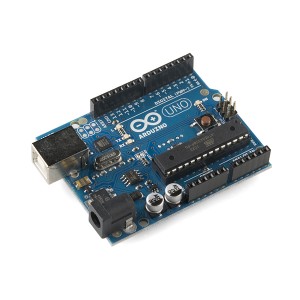This is a really neat little board available from SparkFun. It allows you to interface an android phone to an array of microcontroller-like outputs and inputs (PWN, SPI, ADC, etc). The project has many ready-made Android code examples to get you running and I’m thinking about trying this out! The page linked shows some projects that others have done, and it’s easy to start thinking about all the cool things you could do with this (especially on a dual core Android like mine!) 
Monthly Archives: January 2012
Android IOIO Board
Getting Started with Arduino
Lifehacker posted a great starter article on using an Arduino, with a specific focus on recreating cool projects you see out on the web. This is a great way to start teaching yourself some of the slightly more complex things you can do with a uC, as doing is the best way to learn.
Wavetable Synthesis
One of my favorite classes in college was a micro-controller course where we had to build an alarm-clock radio. For extra credit, I wrote a very simple “music” module to allow students to write songs to use as alarms (instead of a boring tone or siren.) At the time I wondered if there was a way to play real midis or multiple frequencies at once to make more advanced songs. Sadly, I was a busy student and didn’t have time to look into it.
Now, far too late for class, I’ve come across a project using wavetable synthesis which would have been an excellent jump point for me to implement a more advanced music module. I’ll have to play around with this concept and see if I can’t slip a new module to my old professor.
“Universal” RFID key
Here’s another project I’ve wanted to try out for a long time: An update-able RFID key card. I always thought it would be fun to build one of these along with an RFID reader so you could try to reproduce the functionality of a RFID card you have on a new device. It would also be an excellent learning tool on how RFID works and the vulnerabilities it possesses.

Digital Picture Frame Hacking
This is a really cool project that I’ve always wanted to try myself. Some folks hacked a cheap digital picture frame and got it to run Linux. Add a touchscreen overlay and working bluetooth and you’ve got yourself a really amazing toy to play around with. I may just grab one myself and see if I can’t get this working!

Rainmeter Skin

I finally decided to start using Rainmeter to monitor my system resources. I had previously used some
(admittedly very good) windows 7 widgets you can find here, but I’ve always liked the way Rainmeter looked better. When I tried to use it in the past I was turned off by the initial learning curve, specifically in customizing the ‘skins’. For example, I have a 6 core CPU but the Enigma theme only supported monitoring of 2. Today I finally decided to bite the bullet and learn some of the odd meta language used to customize Rainmeter skins and managed to create a 6 CPU system monitor solution:
This uses 2 skins…the original system skin supporting 2 CPUs and an additional ‘System2’ skin I created which adds CPUs 3-6. For those who might want to use it, I’ve uploaded the 2 files needed here. They’ll both need to be renamed as ‘.ini’ as I can’t upload ini files. The first will need to go in “…/Rainmeter/Skins/Enigma/Sidebar/System2” (a new folder) as System.ini
System.ini in Enigma/Sidebar/System2
The second will need to go in “…/Rainmeter/Skins/Enigma/Resources/Styles/Enigma Dark” (or you can make a similar new file in light) as SidebarSystem2.inc
SidebarSystem2.inc in Enigma/Resources/Styles/Enigma Dark
Boxie is Awesome
You need to check out this cool robot from MIT. It uses social behavior and ‘cuteness’ to avoid the need for complex systems.
Keyboard Breakout Board on the Cheap
Here’s a great How-To on turning an old keyboard into a breakout board to use for projects. I can see this being really useful in a MAME build or as a control interface for a uC project if you wanted to avoid buying an I-PAC or something similar.
Note: After doing some reading, this wouldn’t actually be ideal for a MAME build. Keyboards have issues with ‘Blocking’, meaning that you can’t always press multiple keys simultaneously. A device like the aforementioned I-PAC solves this by scanning each key input pin individually, allowing you to press as many keys at once as necessary.
Pinball Machine Emulator
I’ve seen (and heavily considered stealing) many Arcade/MAME cabinet builds over the years…but this is a first. A custom build Pinball Machine Cabinet for emulated pinball games. It uses 3 LCD screens (marque, dot matrix, and play field) and a ton of little hardware bits to reproduce the sounds, vibrations, and knocks one would feel on a real machine. Really amazing!
Reflow Oven
A reflow oven is an absolute must if you plan on doing projects with many surface mount parts. Hack-A-Day has featured many examples of home made reflow ovens, usually using a toaster oven and a microcontroller to do the work for you. This post uses that approach and has a very detailed guide on getting started building your own.

